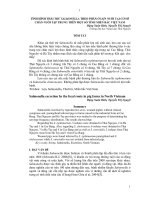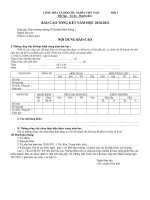Báo cáo 1 TN XLSTH
Bạn đang xem bản rút gọn của tài liệu. Xem và tải ngay bản đầy đủ của tài liệu tại đây (224.49 KB, 19 trang )
ĐẠI HỌC QUỐC GIA THÀNH PHỐ HỒ CHÍ MINH
TRƯỜNG ĐẠI HỌC BÁCH KHOA
KHOA ĐIỆN – ĐIỆN TỬ
--------------------
BÁO CÁO THÍ NGHIỆM XỬ LÝ SỐ TÍN HIỆU
BÀI 1: GIỚI THIỆU MATLAB CƠ BẢN
THỰC HÀNH 1. Viết file-M thực hiện đoạn chương trình sau
- Code Matlab:
clc;
clear all;
x = 0:pi/20:2*pi; % define vector x from 0 to 2pi with step size pi/100
y = sin(x);
% define vector y
subplot(1,2,1); %create a graph with 2 subgraphs in 1 row 2 columns
% and with subplot position 1
plot(x,y,'r-'); % plot x versus y
axis ([0 2*pi -1 1]);
xlabel ('x (pi)');
ylabel ('y=sinx');
title ('Graph of continuous sine from 0 to 2pi');
subplot(1,2,2);
stem(x,y,'g-');
axis([0 2*pi -1 1]);
xlabel ('x (pi)');
ylabel ('y=sinx');
title ('Graph of discrete sine from 0 to 2pi');
- Kết quả mô phỏng:
clc;
close all;
xn = [1, 2, 3, 4, 5, 6];
L = length(xn);
%find the length of the sequence
Xk = zeros(1,L);
%initialize an array of same size as that of input sequence
%DFT of the sequence
for k = 0:L-1
for n = 0:L-1
Xk(k+1) = Xk(k+1) + xn(n+1)*exp(-1j*2*pi*k*n/L);
end
end
% Using FFT Matlab
Xk_2 = fft(xn,L);
THỰC
HÀNH 2.
Viết một
file-M
thực hiện
chương
trình sau.
- Code
Matlab:
- Kết quả
mô phỏng:
%Plotting input sequence
t=0:L-1;
subplot(1,3,1);
stem(t,xn);
ylabel ('Amplitude');
xlabel ('Time Index');
title('Input Sequence');
t=0:L-1;
% Find the magnitudes of individual DFT points
Xk_magnitude = abs(Xk);
Xk_2_magnitude = abs(Xk_2);
% plot the magnitude response
subplot(1,3,2);
stem(t,Xk_magnitude,'bo-'); hold on;
stem(t,Xk_2_magnitude,'r*--'); hold on;
ylabel ('Amplitude');
xlabel ('K');
title('Magnitude Response');
% Find the phases of individual DFT points
Xk_phase = angle(Xk);
Xk_2_phase = angle(Xk_2);
% plot the magnitude sequence
subplot(1,3,3);
stem(t,Xk_phase,'bo-'); hold on;
stem(t,Xk_2_phase,'r*--'); hold on;
ylabel ('Phase');
xlabel ('K');
title ('Phase Response');
legend('Computing', 'fft Matlab');
THỰC HÀNH 3. Viết chương trình thwujc hiện biến đổi IDFT của chuỗi X(k) = [10, -2+2i, -2,
-2-2i] theo 2 cách.
- Code Matlab:
- Kết quả
mô phỏng:
clc;
close all;
xk = [10,-2+2j,-2,-2-2j];
L = length(xk);
%find the length of the sequence
Xn = zeros(1,L);
%initialize an array of same size as that of input sequence
%IDFT of the sequence
for n = 0:L-1
for k = 0:L-1
Xn(n+1) = Xn(n+1) + (1/L)*xk(k+1)*exp(1j*2*pi*k*n/L);
end
end
% Using IDFT Matlab
Xn_2 = ifft(xk,L);
stem(0:L-1,Xn,'b-');
hold on;
stem(0:L-1,Xn_2,'r*--');
THỰC HÀNH 4. Viết một file-M tìm ngõ ra y(n) của hệ thống nhân quả với ngõ vào x(n) =
[1,3,5,3,6,3] và đáp ứng xung h(n) = [1,4,7,2,8] theo 2 cách.
- Code Matlab:
clc;
clear all;
xn = [1,3,5,3,6,3];
hn = [1,4,7,2,8];
% tinh tich chap
Lx = length(xn);
N = length(hn);
M = N - 1;
Ly = Lx + M;
yn = zeros(1, Ly);
for n = 0 : Ly-1
for m = max(0,n-Lx + 1):min(n,M)
yn(n+1) = yn(n+1) + hn(m+1) * xn(n-m+1);
end
end
fprintf('yn = ');
disp(yn);
% dung ham conv
yn_2 = conv(xn,hn);
fprintf('\n yn_2 =');
disp(yn_2);
stem(0:Ly-1,yn,'b-');
hold on;
stem(0:Ly-1,yn_2,'r*--');
- Kết quả mô phỏng:
THỰC HÀNH 5. Viết một file-M vẽ đáp ứng tần số của hệ thống có hàm truyền trên theo 2 cách.
- Code Matlab:
clc;
clear all;
w = 0:pi/10:pi;
% tinh toan dap ung tan so
H = (5 + 2*exp(-1j*w))./(1-0.8*exp(-1j*w));
H_manitude = abs(H);
H_phase = angle(H);
subplot(2,2,1);
semilogy(w,H_manitude,'r-');
grid on;
title('Amplitude tinh toan');
xlabel('w (pi)');
subplot(2,2,2);
plot(w,H_phase,'b-');
grid on;
title('Phase tinh toan');
xlabel('w (pi)');
% su dung ham matlab
a = [1,-0.8];
b = [5,2];
[H_matlab,w] = freqz(b,a);
H_matlab_mantitude = abs(H_matlab);
H_matlab_phase = angle(H_matlab);
subplot(2,2,3);
semilogy(w,H_matlab_mantitude,'r-');
grid on;
xlabel('w (pi)');
title('Amplitude ham matlab');
subplot(2,2,4);
plot(w,H_matlab_phase,'b-');
grid on;
xlabel('w (pi)');
title('Phase ham matlab');
- Kết quả mô phỏng:
THỰC HÀNH 6_1. Viết chương trình Matlab thực hiện yêu cầu sau:
Tạo 5 chu kỳ mẫu tín hiệu
s1 = cos ( 2π f 1t )
f =
với 1
400 Hz, tần số lẫy mẫu 8000 Hz
- Code matlab:
clc;
clear all;
% Signal Genergating
Fs = 8e3;
% Sampling frequency 8 kHz
Ts = 1/Fs;
% Sampling period
F_xt = 400;
% Frequency of signal 300 Hz
T_xt = 1/F_xt;
t = 0 : Ts : 5*T_xt;
xn = cos(2 * pi * F_xt * t);
N = length(xn); % DFT length = signal length
Xk = fft(xn, N); % DFT of signal
Xk_Man = abs(Xk);
Xk_Pha = angle(Xk);
%% Signal plot
figure(1);
subplot(1,2,1);
hold on;
plot(t, xn);
xlabel('Time (sec)');
ylabel('Amplitude');
subplot(1,2,2);
hold on;
plot(0:N-1, xn);
xlabel('Sampling index - n');
ylabel('Amplitude');
%% Spectrum plot
figure(2);
subplot(1,2,1);
stem((0:N/2-1)*Fs/N, Xk_Man(1:N) / N);
xlabel('Frequency (Hz)');
ylabel('Amplitude');
subplot(1,2,2);
plot((0:N-1)*Fs/N, Xk_Pha(1:N) );
xlabel('Frequency (Hz)');
ylabel('Phase');
- Kết quả mô phỏng:
1 T 4 ≤ t < 3T 4
s3 =
0 elsewhere
THỰC HÀNH 6_2. Tạo mẫu tín hiệu
được lấy mẫu với 20 trong 1
chu kỳ T.
- Code Matlab:
clc;
clear all;
Fs = 20;
Ts = 1/Fs;
T = 1;
t = 0 : Ts : T-Ts;
xn = [0,0,0,0,0,1,1,1,1,1,1,1,1,1,1,0,0,0,0,0];
L = length(xn);
Xk = fft(xn,L);
Xk_Man = abs(Xk);
Xk_Pha = angle(Xk);
%% Signal plot
figure(1)
subplot(1,2,1)
plot(t, xn);
xlabel('Time (sec)');
ylabel('Amplitude');
subplot(1,2,2)
plot(0:L-1,xn);
xlabel('Sampling index - n');
ylabel('Amplitude');
%% Spectrum plot
figure(2)
subplot(1,2,1)
stem((0:L-1)*Fs/L, Xk_Man(1:L) / L);
xlabel('Frequency (Hz)');
ylabel('Amplitude');
subplot(1,2,2)
stem((0:L-1)*Fs/L, Xk_Pha(1:L) );
xlabel('Frequency (Hz)');
ylabel('Phase');
- Kết quả mô phỏng:
THỰC HÀNH 6_3. Tạo tín hiệu sinc
s 4 = sinc ( 2π f 4 ( t − 0.5) )
và được lấy mẫu ở tần số 500 Hz.
- Code Matlab:
clc;
clear all;
Fs = 500;
Ts = 1/Fs;
F = 40;
T_sim = 1;
t = 0:Ts:1-Ts;
xn = sinc(2 * pi * F * (t-0.5));
N = length(xn);
Xk = fft(xn, N);
Xk_Man = abs(Xk);
Xk_Pha = angle(Xk);
%% Signal plot
figure(1)
subplot(2,1,1)
plot(t, xn);
grid on;
xlabel('Time (sec)');
ylabel('Amplitude');
title('Truoc khi lay mau ');
subplot(2,1,2)
plot(0:N-1, xn,'r-');
grid on;
xlabel('Sampling index - n');
ylabel('Amplitude');
title('Sau khi lay mau');
%% Spectrum plot
figure(2)
subplot(2,1,1)
stem((0:N-1)*Fs/N, Xk_Man(1:N) / N);
xlabel('Frequency (Hz)');
ylabel('Amplitude');
title('Bien do');
subplot(2,1,2)
stem((0:N-1)*Fs/N, Xk_Pha(1:N));
xlabel('Frequency (Hz)');
ylabel('Phase');
title('Pha');
với
f 4 = 40 Hz, 0 ≤ t < 1 (s)
- Kết quả mô phỏng:
THỰC HÀNH 7. Thực hiện việc thiết kế bộ lọc FIR chắn dải với các thơng số như trong ví
dụ 1. Lấy các hệ số của bộ và viết chương trình vẽ đáp ứng tần số của bộ lọc trên.
- Code Matlab:
- Kết quả
mô
phỏng:
h = bs2700.tf.num;
[H_matlab,w] = freqz(h);
H_matlab_manitude = abs(H_matlab);
H_matlab_phase = angle(H_matlab);
subplot(2,1,1);
semilogy(w,H_matlab_manitude,'r'); %plot
xlabel('w(pi)');
title('do thitheo semilogy');
subplot(2,1,2);
plot(w,H_matlab_manitude,'b-');
xlabel('w(pi)');
title('do thi plot');
THỰC HÀNH 8. Thực hiện việc thiết kế bộ lọc IIR chắn dải với các thơng số như trong ví
dụ 2. Lấy các hệ số của bộ và viết chương trình vẽ đáp ứng tần số của bộ lọc trên.
- Code Matlab :
- Kết quả
mô
phỏng :
[z,p,k] = tf2zp(bs1750.tf.num, bs1750.tf.den);
sos = zp2sos(z,p,k);
[H_matlab,w] = freqz(sos);
H_matlab_mantitude = abs(H_matlab);
H_matlab_phase = angle(H_matlab);
subplot(2,1,1);
semilogy(w,H_matlab_mantitude,'r');
xlabel('w (pi)');
subplot(2,1,2);
plot(w,H_matlab_mantitude,'b-');
xlabel('w (pi)');
THỰC HÀNH 10. Thiết kế bộ lọc FIR chắn đa dải 1000-1500 và 2500-3000, có bậc 62,
tần số lấy mẫu là 10 kHz. Sau đó vẽ đáp ứng tần số của bộ lọc.
- Code Matlab:
- Kết quả
mô
clc;
clear all;
phỏng :
f = [0 0.18 0.2 0.3 0.32 0.48 0.5 0.6 0.62 1];
m = [1 1 0 0 1 1 0 0 1 1];
n = 62;
cof = remez(n-1,f,m);
% frequency response with 256 points
[h, w] = freqz(cof,1,256);
% plot magnitude of the filter
plot(f * 5000,m, 'g'); hold on;
plot(w/pi*5000,abs(h), 'r-.');
THỰC HÀNH 11. Thiết kế bộ lọc IIR chắn đa dải 1000-1500 và 2500-3000, có bậc 62, có
tần số lấy mẫu là 10 kHz. Sau đó vẽ đáp ứng tần số của bộ lọc.
- Code Matlab:
- Kết quả
mô
phỏng :
clc;
clear all;
f = [0 0.18 0.2 0.3 0.32 0.48 0.5 0.6 0.62 1];
m = [1 1 0 0 1 1 0 0 1 1];
n = 62;
[num, den] = yulewalk(n-1,f,m);
% frequency response with 256 points
[h w] = freqz(num,den,256);
% plot magnitude of the filter
plot(f * 5000,m, 'g');
hold on;
plot(w/pi*5000,abs(h), 'r-.');









